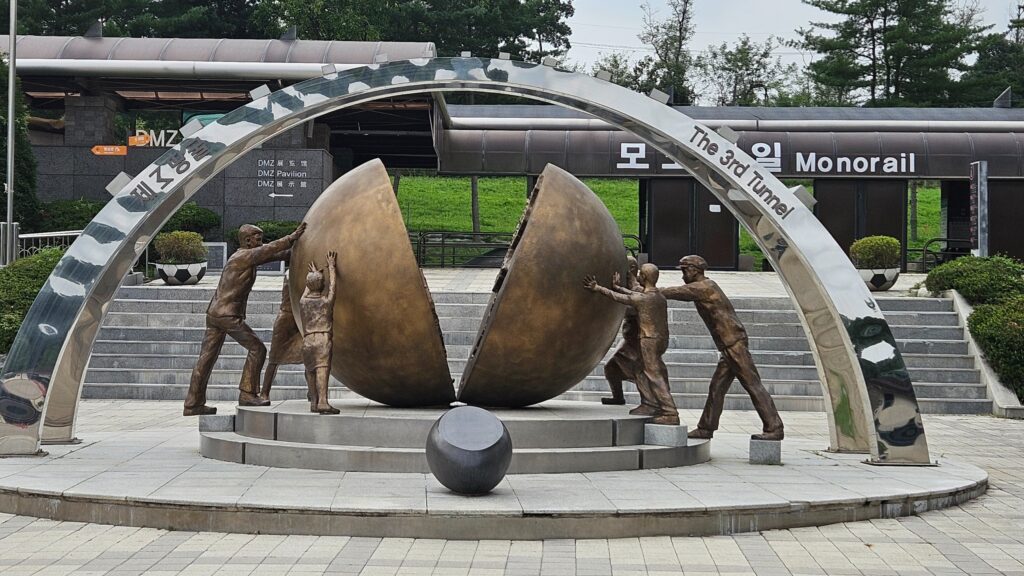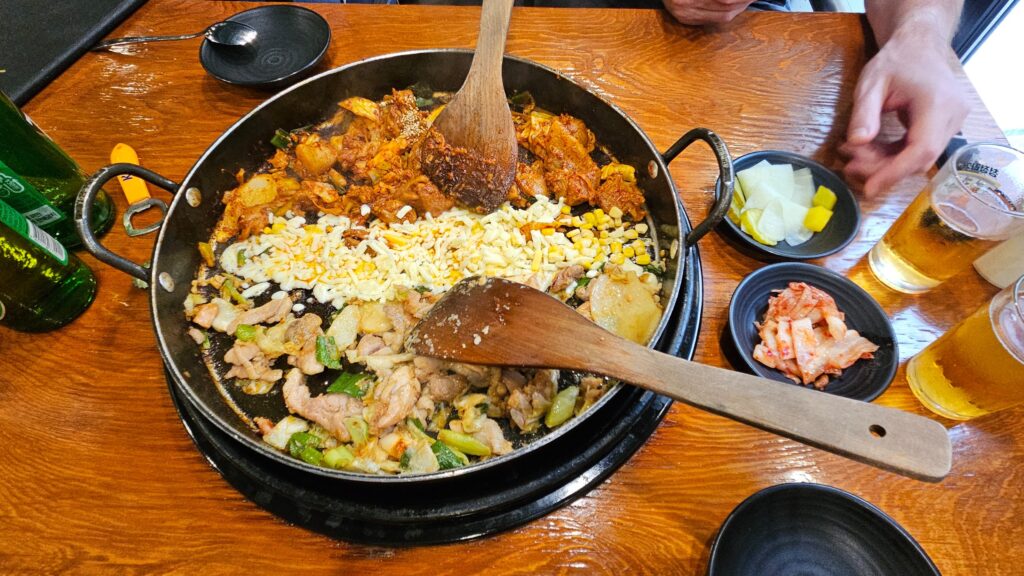
DAY 3
(Reading time: 6 minutes)
I didn’t sleep all night. Not a single minute. I can’t say I didn’t shut my eyes, though, because I spent long time lying completely still, pressing my eyelids shut, hoping for sleep. But it never came—like Godot, it just didn’t show up. If it was jet lag that stole my much-needed rest, it took its time, because the two previous nights went just fine.
Somehow, after the alarm rang, I didn’t feel like a zombie. Maybe it was because I knew what awaited us today: a trip to the DMZ (Demilitarized Zone, a border barrier between North and South Korea).
Five years ago, we took a tour to the North Korean border through a local travel agency, and despite all the hiccups, it turned out way better than we had expected (check out the article North Korea “up close”). This time, we wanted to see other interesting spots near the border, and finding a tour was made easy through Booking.
You can choose from various combinations, most often including the Dora Observatory + Third Infiltration Tunnel, and you often only need to book two days in advance. The tours are popular, well-organized, and there are plenty of spots for visitors. After paying for your booking, you wait for an email confirmation and receive a barcode, which you show to the guide, along with details about the meeting point.

We chose a full-day tour, which included the Dora Observatory, the Third Tunnel, Imjingak Memorial Park, and a suspension bridge near Mount Gamaksan.
We double-checked the meeting point at Exit 8 of Myeongdong Station (7:00 AM) the night before. That morning, the area was a bit chaotic, as Exit 8 is unsurprisingly between Exits 7 and 9, where, of course, other groups were meeting for different DMZ tours. Buses, drivers, and thankfully, guides directing tourists to the right bus were everywhere.
It took about an hour and a half from central Seoul to reach our first stop. We saw a suspension bridge, which happens to be one of the longest in the country. It wasn’t thematically tied to the DMZ, but we considered it an interesting bonus.

From where the bus stopped, it took about 10 minutes uphill to reach the bridge, walking on a path fully covered with rope carpeting.

Koreans (and as we discovered last year, also Taiwanese) love easy hikes on safe, well-marked paths, so most popular trails are “carpeted” or you walk up stairs all the way to the top. I bet European-style mountain hiking would be kind of overwhelming for them.
Our second stop was Imjingak Park, situated 7 km from the DMZ, which means you can access it without any special checks. The park is divided into sections mainly dedicated to the post-war division of the two Koreas and the Korean War (1950-53).

“The Bridge of Freedom” (see below) served as an access point to the railway bridge called “Freedom Bridge,” where the two Koreas exchanged war prisoners (part of it can be seen in the same photo on the right).

At the Mangbaeddan memorial, South Koreans come to pay their respects if their families or family members remain(ed) in North Korea.

The Peace Train locomotive pulled the last train traveling from North to South Korea. Its rust serves as a reminder of how long the countries have been divided.

Prayers for unification (a barbed wire fence with prayers for reunification) and Peace Bell (a bell as a traditional Korean symbol of hope) are other spots commemorating history.
Next, we continued into the DMZ zone.
Get your passports ready, remove glasses and headgear, and don’t photograph soldiers!
Entering the demilitarized zone requires a valid passport. If you forget it, forget the tour. And try to look like your passport photo—you know how hard it is for them to tell us apart. 😊
The Third Infiltration Tunnel is one of the most popular attractions in the entire DMZ; just knowing that it was dug by North Koreans for the purpose of attacking South Korea fills you with unease, but also greater curiosity.


It dates back to the 1970s and its existence was revealed by a North Korean defector. The tunnel lies 73 meters underground and stretches 1,635 meters in length, 435 of which extend into the South Korean demarcation line.
And why is it called the “Third”? Because it’s one of four infiltration tunnels discovered so far. Who knows how many more are out there… specialists are constantly working to find them.
The “Third Tunnel” is the only one that allows entry for tourists.

We had to leave everything, including our phones, in secure lockers (only a small bottle of water is permitted in the tunnel). We passed through a security checkpoint—yes, some people set off alarms as they tried to smuggle in their phones…, received helmets, and descended down a 300-meter-long corridor into the depths of the earth.
The tunnel itself has quite a low ceiling; even at a height of 1.61m, I often had to duck my head, while Mark was hunched or crouched the entire time. At the end of the accessible part of the tunnel, there’s a concrete wall with a small window. As part of a security mechanism, there are three similar walls spaced apart, and the entire area is under continuous camera surveillance. At this point, we were only 170 meters away from the North Korean demarcation line.
On a hill near the tunnel stands the Dora Observatory.
From Dora, you can see:
– Panmunjeom JSA (Joint Security Area) – those blue huts, the only place in the DMZ where North and South Korea come face to face.
– 2 opposing villages (South Korean Daeseong and North Korean “Potemkin” Kijong—you’ll recognize them by their flagpoles).
– the city of Kaesong (the former capital of the Goryeo dynasty), nearby mountain ranges, and farmland.
Visibility, of course, depends on whatever weather the Great Leader decides for that day. We had a bit of a foggy view.
The final stop of the tour was more commercial. We were dropped off on the edge of Tongil Chon village, still within the DMZ, but here we were supposed to eat and buy souvenirs—in other words, spend some Korean won to support the local residents. An interesting fact is that the residents here pay lower taxes than other Koreans. But that comes at the price of living in a buffer zone. If war breaks out, they’re the first in line.
We returned to Seoul around 4 PM, pleasantly tired and hungry. We recharged with delicious dakgalbi in a hot pan with a cheese river.

And back at the hotel, we tried something completely new—doing laundry. I mean, laundry while traveling, of course! The heat, humidity, and constant walking naturally produce a lot of dirty clothes. So we made use of the hotel’s washers and dryers (not free, by the way). Instructions in English helped us navigate buying detergent from the machine and selecting the wash and dry programs (little did we know how much we’d appreciate this practice in the future).


After a job well done, the room was filled with the scent of cleanliness, and I finally drifted off to dreamland with Mark.
-endy-